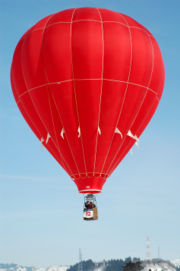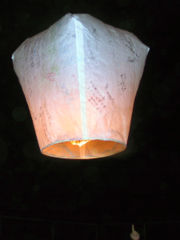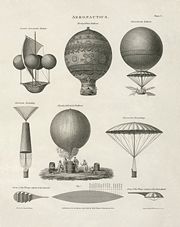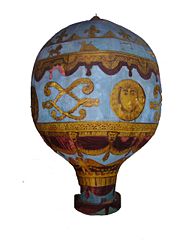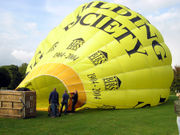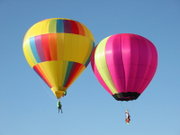Hot air balloon
2008/9 Schools Wikipedia Selection. Related subjects: Air & Sea transport
The hot air balloon is the oldest successful human-carrying flight technology, dating back to its invention by the Montgolfier brothers in Annonay, France in 1783. The first flight carrying humans was made on November 21, 1783, in Paris by Jean-François Pilâtre de Rozier and François Laurent d'Arlandes.
Hot air balloons that can be propelled through the air rather than just being pushed along by the wind are known as airships or, more commonly, thermal airships.
A hot air balloon consists of a bag called the envelope that is capable of containing heated air. Suspended beneath is the gondola or wicker basket (in some long-distance or high-altitude balloons, a capsule) which carries the passengers and a source of heat. The heated air inside the envelope makes it buoyant since it has a lower density than the relatively cold air outside the envelope. Unlike gas balloons, the envelope does not have to be sealed at the bottom since the rising hot air only exerts pressure on the upper hemisphere of the balloon to provide lift. In today's sport balloons the envelope is generally made from nylon fabric and the mouth of the balloon (closest to the burner flame) is made from fire resistant material such as Nomex.
Recently, balloon envelopes have been made in fantastic shapes, such as hot dogs, rocket ships, and the shapes of commercial products.
History
Premodern Balloon
Unmanned hot air balloons are popular in Chinese history. Zhuge Liang of the Shu Han kingdom, in the Three Kingdoms era, used airborne lanterns for military signaling. These lanterns are known as Kongming lanterns (孔明灯).
There is also some speculation that hot air balloons were used by the Nazca Indians of Peru some 1500 years ago as a tool for designing vast drawings on the Nazca plain.
A method of making objects float in the air on their own accord by means of hot air is discussed by the 11th century C.E. jewish scholar Rashi in his commentary on the bible "Even were you to fill an eggshell membrane with dew and close up its opening and place it in the sun, it will, on its own, rise into the air"
First recorded manned balloon flight
The first clearly recorded instances of balloons capable of carrying passengers used hot air to obtain buoyancy and were built by the brothers Joseph-Michel and Jacques-Etienne Montgolfier in Annonay, France. These brothers came from a family of paper manufacturers and had noticed the ash rising in fires. After experimenting with unmanned balloons and flights with animals, the first balloon flight with humans on board took place on October 19, 1783 with the scientist Jean-François Pilâtre de Rozier, the manufacture manager, Jean-Baptiste Réveillon and Giroud de Villette, at the Folie Titon in Paris. Officially, the first flight was 1 month later, 21 November 1783. King Louis XVI had originally decreed that condemned criminals would be the first pilots, but a young physicist named Jean-François Pilâtre de Rozier and the Marquis Francois d'Arlandes successfully petitioned for the honour. The first hot air balloons were basically cloth bags (sometimes lined with paper) with a smoky fire built on a grill attached to the bottom. They had a tendency to catch fire and be destroyed upon landing, although this was infrequent.
Military use
The first military use of aircraft in Europe took place during the French Revolutionary Wars, when the French used a tethered hydrogen balloon to observe the movements of the Austrian army during the Battle of Fleurus (1794). Hot air balloons were employed during the American Civil War. Though the military balloons used by the Union Army Balloon Corps under the command of Prof. Thaddeus S. C. Lowe were limp silk envelopes inflated with coke gas (town gas) or hydrogen.
The first modern day hot air balloon to be built in the United Kingdom (UK) was the Bristol Belle in 1967.
Today
Today, hot air balloons are used primarily for recreation. There are some 7,500 hot air balloons operating in the United States.
Hot air balloons are able to fly to extremely high altitudes. On November 26, 2005, Vijaypat Singhania set the world altitude record for highest hot air balloon flight, reaching 21,290 metres (69,849 feet). He took off from downtown Bombay, India and landed 240 kilometres (149 miles) south in Panchale. The previous record of 19,811 m (64,997 ft) had been set by Per Lindstrand on June 6, 1988 in Plano, Texas. As with all registered aircraft, oxygen is needed for all crew and passengers for any flight that reaches and exceeds an altitude of 12,500 ft (3,810 m).
The farthest that a hot air balloon has ever been flown is 7,671.91 km (4,767.1 mi). On January 15, 1991, the Virgin Pacific Flyer balloon completed the longest flight in a hot air balloon when Per Lindstrand (born in Sweden, but resident in the UK) and Richard Branson of the UK flew from Japan to Northern Canada.
With a volume of 74,000 cubic metres (2,600,000 cubic feet), the balloon envelope was the largest ever built for a hot air craft. Designed to fly in the trans-oceanic jet streams the Pacific Flyer recorded the highest ground speed for a manned balloon at 245 miles per hour (394 km/h).
The longest duration hot air balloon flight ever made is 50 hours and 38 minutes made by Michio Kanda and Hirosuke Tekezawa of Japan on January 2, 1997.
Construction
A hot air balloon for manned flight uses a single-layered, fabric gas bag (lifting "envelope"), with an opening at the bottom called the mouth or throat. Attached to the envelope is a basket, or gondola, for carrying the passengers. The basket is usually made of wicker and rattan, but can be made of aluminium. Mounted above the basket and centered in the mouth is the "burner" which injects a flame into the envelope, heating the air within. The heater or burner is fueled by propane, a liquefied gas stored in pressure vessels, similar to high pressure forklift cylinders.
Envelope
Modern hot air balloons are usually made of light-weight and strong synthetic fabrics such as ripstop nylon, or dacron (a polyester).
During the manufacturing process, the material is cut into panels and sewn together, along with structural load tapes (webbing) that carry the weight of the gondola or basket. Vertical rows of triangular panels that are referred to as gores. Envelopes can have as few as 4 gores or as many as 24 or more.
Envelopes often have a crown ring at their very top. This is a hoop of smooth metal, usually aluminium and approximately 1 ft (0.3 m) in diameter, to which vertical load tapes attach.
Fabric coatings
The fabric (or at least part of it, the top 1/3 for example) may be coated with a sealer, such as silicone or polyurethane, to make it impermeable to air. It is often the degradation of this coating and the corresponding loss of impermiability that ends the effective life of an envelope, not weakening of the fabric itself. Heat, moisture, and mechanical wear-and-tear during set up and pack up are the primary causes of degradation. Once an envelope becomes too porous to fly, it may be retired and used as a 'rag bag': cold inflated and opened for children to run through. Products for recoating the fabric are becoming commercially available.
Envelope sizes
A range of envelope sizes is available. The smallest, one-person, basket-less balloons (called " Hoppers" or "Cloudhoppers") have less than 1,000 m³ (35,000 ft³) of envelope volume (for a perfect sphere this would mean a radius of around 13.3 m (43.6 ft)). At the other end of the scale are the balloons used by large commercial sightseeing operations that carry well over two dozen people and have envelope volumes of up to 15,000 m³ (600,000 ft³). However, most balloons are roughly 2,500 m³ (100,000 ft³) and carry 3 to sometimes 4 people.
Vents
The top of the balloon usually has a vent of some sort. The most common type of vent is a disk-shaped flap of fabric called a parachute vent. The fabric is connected around its edge to a set of "vent lines" that converge in the centre. (The arrangement of fabric and lines looks roughly like a parachute -- thus the name.) These "vent lines" are themselves connected to a control line that runs to the basket. A parachute vent is opened by pulling on the control line. Once the control line is released, the pressure of the remaining hot air pushes the vent fabric back into place. A parachute vent can be opened briefly while in flight to initiate a rapid descent. (Slower descents are initiated by allowing the air in the balloon to cool naturally.) The vent is pulled completely open to collapse the balloon after landing.
An older, and today less commonly used, style of vent is called a " Velcro-style" vent. This too is a disk of fabric at the top of the balloon. However, rather than having a set of "vent lines" that can repeatedly open and close the vent, the vent is secured by "hook and loop" fasteners (such as Velcro) and is only opened at the end of the flight. Balloons equipped with a "Velcro-style" vent typically have a second "maneuvering vent" built into the side (as opposed to the top) of the balloon.
Some hot air balloons have turning vents which are side vents which, when opened, cause the balloon to rotate. Such vents are particularly useful for balloons with rectangular baskets in order to align the wider side of the basket for landing.
Burner
The burner unit gasifies liquid propane, mixes it with air, ignites the mixture, and directs the flame and exhaust into the mouth of the envelope. The unit may consist of one or more individual burners of which the pilot may use one or more at a time to generate the desired heat. Each burner is characterized by a metal coil of propane tubing through which the flame shoots in order to preheat the incoming liquid propane.
The burner unit may be suspended from the mouth of the envelope, or rigidly supported over the basket. The burner unit may be mounted on a gimbal to enable the pilot to aim the flame and avoid overheating the envelope fabric.
The pilot actuates a burner by opening a propane valve, called a blast valve. The valve may be spring loaded so that it closes automatically, or it may stay open until closed by the pilot. The burner has a pilot light to ignite the propane and air mixture. The pilot light may be lit by the pilot with an external device, such as a flint striker or a lighter, or with a built-in piezo electric spark.
A burner may have a secondary propane valve that releases propane more slowly and thereby generates a different sound. This is called a whisper burner and is used for flight over livestock to lessen the chance of spooking them. It also generates a more yellow flame and is used for night glows because it lights up the inside of the envelope better than the primary valve.
Burners can generate heat on the order of 30 million BTUs (31,651,677 kilojoule).
Fuel tanks
Propane fuel tanks are usually cylindrical pressure vessels made from aluminium, stainless steel, or titanium with a valve at one end to feed the burner and to refuel. They may have a fuel gauge and a pressure gauge. Common tank sizes are 10 (38), 15 (57), and 20 (76) US gallons ( litres).
The pressure necessary to force the fuel through the line to the burner may be supplied by the vapor pressure of the propane itself, if warm enough, or by the introduction of an inert gas such as nitrogen. Tanks may be preheated with electrical heat tapes to produce sufficient vapor pressure for cold weather flying. Warmed tanks will usually also be wrapped in an insulating blanket to preserve heat during the setup and flight.
Instrumentation
A balloon may be outfitted with a variety of instruments to aid the pilot. These commonly include an altimeter, a rate of climb (vertical speed) indicator, envelope (air) temperature, and ambient (air) temperature. A GPS receiver can be useful to indicate ground speed (traditional aircraft air speed indicators would be useless) and direction.
Combined mass
The combined mass of an average system can be calculated as follows
- the envelope: 250 lb, 113 kg
- basket: 140 lb, 63.5 kg
- burner: 50 lb, 22.7 kg
- 3 fuel tanks with fuel: 3 × 135 lb = 405 lb, 184 kg
- 5 passengers: 5 × 150 lb each = 750 lb, 340 kg
- the air in the envelope (100,000 ft³ at 0.062 lb/ft³ = 3.1 tons, 2,812 kg) - but at 120 °C, the density of dry air is 0.898 kg/m³ which is 0.056 lb/ft³, giving a weight of 2,551 kg
For a total of 3,538 kg or about 3.9 tons (or 3,227 kg with the adjustment above)
Theory of operation
Generating lift
Raising the air temperature inside the envelope makes it lighter than the surrounding (ambient) air. This causes the balloon and its payload to rise. The amount of lift (or buoyancy) provided by a hot air balloon depends primarily upon the difference between the temperature of the air inside the envelope and the temperature of the air outside the envelope. For most envelopes made of nylon fabric, the maximum internal temperature is limited to approximately 120 °C (250 °F). It should be noted that the melting point of nylon is significantly higher than these maximum operating temperature — about 230 °C (450 °F). However the lower temperatures are generally used because the higher the temperature, the more quickly the strength of the nylon fabric degrades over time. With a maximum operating temperature of 120 °C (250 °F), balloon envelopes can generally be flown for between 400 and 500 hours before the fabric needs to be replaced. Many balloon pilots operate their envelopes at temperatures significantly below the maximum in order to extend the longevity of their envelope fabric.
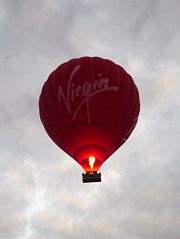
For typical atmospheric conditions, a hot air balloon requires about 3 m³ of envelope volume in order to lift 1 kilogram (50 ft³/lb). The precise amount of lift provided depends not only upon the internal temperature mentioned above, but the external temperature, altitude above sea level, and humidity of the surrounding air.
On a hot day, the balloon cannot be loaded as much as on a cool day, because the temperature required for launch will exceed the maximum sustainable for nylon envelope fabric.
In the lower atmosphere, the lift provided by a hot air balloon decreases about 3% for each 1,000 meters (1% per 1,000 ft) of altitude gained.
A note on the physics: according to Archimedes' principle, the uplift on a balloon is equal to the weight of unheated air displaced by the balloon. As the density of air at 20 °C is about 1.2 kg/m³ (see density of air) which is 0.07476 lb/ft³, the uplift for a balloon of 100,000 ft³ would be 7476 lb, or 3398 kg. This should be compared with the total mass stated in the previous section.
Hybrids
The Rozière type of hybrid balloon, called after its creator, Jean-François Pilâtre de Rozier, has a separate cell for helium as well as a cone below for hot air (as is used in a hot air balloon) to heat the helium at night.
Solar
Solar balloons are hot air balloons that use just solar energy captured by a dark envelope to heat the air inside.
Safety equipment
To help ensure the safety of pilot and passengers, a hot air balloon may carry several pieces of safety equipment.
In the basket
In order to relight the burner, in case the pilot light goes out and the optional piezo ignition fails, the pilot should have ready access to a flint spark lighter.
Many systems, especially those that carry passengers have completely redundant fuel and burner systems: two fuel tanks, connected to two separate hoses, which feed two distinct burners. This enables a safe landing in the case of a clog somewhere in one system or if a system must be disabled because of a fuel leak.
On the occupants
At a minimum the pilot should wear flame resistant gloves. These can be made of leather or some more sophisticated material, such as nomex. These will enable the pilot to shut off a gas valve in the case of a leak even if there is a flame present. Quick action on the pilot's part to stop the flow of gas can turn a potential disaster into an inconvenience.
At a minimum the pilot should wear clothes made of natural fibers. These will singe and not burn readily if brought into contact with an open flame. Many synthetic fibers, unless especially formulated for use near flame or high temperatures like nomex, will melt onto the wearer and can cause severe burning.
Some balloon systems, especially those that hang the burner from the envelope instead of supporting it rigidly from the basket, require the use of helmets by the pilot and passengers.
On the ground crew
The ground crew should wear gloves on their hands whenever the possibility of handling ropes or lines exists. The mass and exposed surface to air movement of a medium sized balloon is sufficient to cause rope burns to the hands of anyone trying to stop or prevent movement.
The ground crew should also wear sturdy shoes and at least long pants in case of the need to access a landing or landed balloon in rough or overgrown terrain.
Maintenance and repair
As aircraft, hot air balloons require regular maintenance in order to remain airworthy. As aircraft made of fabric and that lack direct horizontal control, hot air balloons may occasionally require repairs to rips or snags.
While some operations, such as cleaning and drying, may be performed by the owner or pilot, other operations, such as sewing, must be performed by a qualified repair technician and recorded in the balloon's maintenance log book.
Maintenance
To ensure long life and safe operation, the envelope should be kept clean and dry. This prevents mold and mildew from forming on the fabric and abrasion from occurring during packing, transport, and unpacking due to contact with foreign particles. In the event of a landing in a wet (because of precipitation or early morning or late evening dew) or muddy location (farmer's field), the envelope should be cleaned and laid out or hung to dry.
The burner and fuel system must also be kept clean to ensure safe operation on demand. Damaged fuel hoses need to be replaced. Stuck or leaky valves must be repaired or replaced.
The wicker basket may require occasional refinishing or repair. The skids on its bottom may require occasional replacement.
Repair
In the case of a snag, burn, or rip in the envelope fabric, a patch may be applied or the affected panel completely replaced. Patches may be held in place with glue, tape, stitching, or a combination of these techniques. Replacing an entire panel requires the stitching around the old panel to be removed, and a new panel to be sewn in with the appropriate technique, thread, and stitch pattern.
Licensing
Depending on the size of the balloon, location, and intended use, hot air balloons and their pilots need to comply with a variety of regulations.
Balloons
In the USA, balloons below a certain size (empty weight of less than 254 pounds or 115 kg) can be used as an ultralight aircraft and cannot carry passengers, except for pilot training. Anything larger than that must be registered (have an N-number), have an airworthiness certificate, and pass annual inspections.
Pilots
In the United States, a pilot of a hot air balloon must have a pilot certificate from the Federal Aviation Administration (FAA) and it must carry the rating of "Lighter-than-air free balloon", and unless the pilot is also qualified to fly gas balloons, will also carry this limitation: "Limited to hot air balloons with airborne heater".
In order to carry paying passengers for hire (and attend some balloon festivals), a pilot must have a commercial pilot certificate. Commercial hot air balloon pilots may also act as hot air balloon flight instructors.
A pilot does not need a license to fly an ultralight aircraft, but training is highly advised, and some hot air balloons meet the criteria.
While most balloon pilots fly for the pure joy of floating through the air, many are able to make a living as a professional balloon pilot. Some professional pilots fly commercial passenger sightseeing flights, while others fly corporate advertising balloons.
